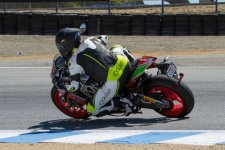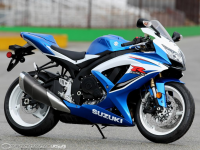The Ontario Safety standard Certificate (SSC) ensures that only safe,
roadworthy vehicles are on the roads in Ontario.
The following items shall be inspected, and the motor vehicle shall be
denied an SSC if:
In the body and interior:
a) any bumper, fender or mudguard has been removed or is mounted insecurely;
b) any body part has protruding sharp edges that could be hazardous to
pedestrians or passengers;
c) any hood latch or passenger door does not operate as intended;
d) the driver's sun visor does not operate properly;
e) any occupant seat is insecure or fails to maintain its adjustment;
f) the inside and/or outside rear-view mirrors are loose, cracked or
have any significant reductions of the reflective surface, or the
inside mirror (where required) is missing;
g) where required, the seat belt assemblies are missing, insecure,
damaged, inoperative or do not function as intended;
h) the frame or any structural unitized member is broken or cracked;
has any loose or missing connecting fasteners; or is perforated with
rust that could downgrade the safety of the vehicle; or
i) The under-body, including the trunk floor pan, is perforated by rust
or damaged or has any opening that may allow entry of exhaust gas.
Glazing
a) any glass, where required, is other than safety glass;
b) any glazing material has exposed sharp edges, a missing part or is insecure;
c) any safety glass in the windshield, or to the left or right of the
driver, has been replaced with any vision-obstructing material,
or is clouded or fogged so as to affect the driver's vision;
d) the windshield has any star, crack or stone chip in the area swept
by the driver's wiper blade that could affect the driver's
vision; or
e) the driver's window does not open freely.
Lighting and Electrical
a) any prescribed lamp fails to operate or interferes with any other circuit;
b) any turn signal indicator lamp fails to operate properly;
c) any lamp or reflector is loose or missing in whole or in part, or
is discolored;
d) any headlamp is covered with a colored lacquer or is fitted with
any device affecting brightness (e.g. headlamp shields);
e) any headlamp shutter or retracting headlamp fails to operate
properly or is not secured in the fully-open position;
f) any headlamp is aligned incorrectly;
g) the headlamp dimmer switch or high-beam indicating light fails to
operate as intended;
h) the horn fails to operate or is insecure on its mount;
i) the windshield wiper/washer assemblies and the heating and
defrosting systems do not function as originally intended;
j) where originally fitted, the neutral safety switch has been removed
or allows the starter motor to operate in any other than the
neutral and park positions; or
k) the speedometer is not in good working order.
"Prescribed Lights" is the phrase used to cover the lighting
requirements of vehicles for the purposes of the HTA, and applies to
all vehicles, including passenger cars, light and heavy trucks and
trailers. "Prescribed Lights" vary with vehicle dimensions and include
the lights listed below:
Headlamps: no more than four, and shall be white or amber in color;
Turn signals: shall be self illuminating;
Stop lights: shall be red or yellow in colour;
Tail Lights: shall be red in colour;
Licence plate: rear plate must be illuminated by a white light;
Reflectors: shall be red in colour, located at the rear and as close
as practical to the outside of the vehicle body (most tail light
lenses incorporate a reflective lens in their construction); and
Side markers: one on each side near the front, green or amber in
colour, and one on each side near the rear, red in colour.
NOTE: Although side marker lights are not required for certification
of a motor vehicle with a length of 6.1 metres (20 feet) or less, the
Canadian Motor Vehicle Safety Standard (CMVSS) requires all vehicles
manufactured on or after January 1, 1971, to be equipped with side
marker lights.
Engine and Controls
a) with the engine running, there is any visible leakage in the fuel
system (the fuel tank does not have to be filled before inspection for
leaks);
b) any attachment or component of the fuel system is insecure or
missing, including a proper fuel filler cap;
c) the accelerator linkage fails to return the engine speed to idle
when the pedal is released; or,
d) the power steering belt is defective, incorrectly adjusted or missing.
Exhaust System and Manifolds
a) any exhaust component is missing or mounted insecurely;
b) any exhaust leakage is present, other than from the manufacturer's
drain holes;
c) any exhaust component is within the occupant compartment, or is so
located or unguarded that any occupant may be burned
by entering or leaving the vehicle; or
d) the exhaust system has been shortened or modified from original, so
as to fail to direct the exhaust beyond the underbody of
the occupant compartment or luggage compartment.
NOTE: Although emission control devices are not required to be
inspected for the purpose of issuing an 550, the motor vehicle will be
in violation of the Environmental Protection Act if any component of
the emission control system is inoperative, defective, has been
removed, or fails to function as intended.
Trailer Hitch
a) any trailer hitch or attachment is damaged, excessively worn or
insecure as to affect its proper operation; or,
b) any trailer hitch lock assembly fails to operate as intended.
Steering and Suspension
a) any visible leakage of fluid is present in the power steering
system or the reservoir fluid level is too low;
b) the steering column, box or couplings are excessively worn or loose
on their mountings, or parts are missing or loose;
c) any steering linkage joint is worn or loose;
d) any steering system, or suspension locking device or clamp is
missing, loose or worn so as to affect its proper operation;
e) the front wheels are visibly out of alignment;
f) the front wheels fail to turn from full right to full left freely;
g) free movement of the steering wheel exceeds manufacturer's limits;
h) the power steering system does not operate as intended;
i) any component, or attachment of the suspension system, or its
supports, is excessively worn, corroded, broken, bent,
cracked, loose, disconnected or missing;
j) the front or rear axles are tracking improperly so as to affect
handling the vehicle;
k) any ball joint is worn beyond manufacturer's limits; or
I) any wheel or axle bearing is excessively worn, loose or damaged.
Wheels and Tires
NOTE: Only those wheels/tires installed on axles are inspected.
a) any wheel-retaining device is worn, defective, loose or missing;
b) any wheel is cracked, excessively bent or has been repaired by welding;
c) any wheel spoke is loose, broken or missing;
d) tire shows any exposed cord;
e) any abnormal bump, bulge or knot is present;
f) any tire makes contact with any vehicle component;
g) any tire bears the markings "not for highway use" or "farm use only";
h) any tire is worn beyond the minimum allowed tread depth; e.g.
built-in wear bar indicators are showing on two adjacent major tread
grooves at three equal spacings around the circumference of the tire;
i) any tire is of a smaller size than vehicle manufacturer's specified
minimum size;
j) any mixture of 50 to 60 series are installed on the front axle and
any other series on the rear;
k) any tire differs in construction type from any other tire on the
same axle; or,
I) except on a vehicle fitted with dual rear tires, any mixture of
radial tires are on the front axle and belted-bias or bias ply tires
are installed on the rear axle.
Brakes
a) any fluid or vacuum leakage is present in the braking system;
b) the brake fluid in the brake master cylinder is below the
manufacturer's recommended minimum level;
c) any brake tubing has heavy corrosion scaling;
d) any vacuum or hydraulic hose or tube is damaged, insecure, missing
or chafes against any part of the vehicle;
e) with the foot brake applied, the brake pedal moves toward the floor;
f) the brakes, including the parking brake, are not adjusted properly;
g) any brake, including the parking brake, fails to release
immediately when the pedal or lever is released;
h) any mechanical, vacuum or hydraulic component is missing, cracked,
loose, badly worn, seized or damaged so as to affect
its operation;
i) any hydraulic component is leaking fluid;
j) with the motor running and the brake pedal applied, the brake
failure warning light comes on;
k) with the vacuum depleted from the power brake (by depressing the
brake pedal three or four times), the motor shut off and
the brake pedal depressed, the pedal fails to move momentarily towards
the floor when the motor is started;
I) any brake drum or rotor is worn beyond the manufacturer's limits,
or the friction surfaces
are damaged mechanically other than from normal wear;
m) any brake rotor cooling fin is cracked or broken;
n) any bonded brake lining is thinner than 1.5 millimeters (1/16 inch)
at its thinnest point;
o) any riveted brake lining is thinner than 0.8 millimeters (1/32
inch) at its thinnest point;
p) any brake lining is broken or loose on its shoe or pad;
q) any brake lining is contaminated;
r) any wheel hub seal, axle seal or oil retainer is missing or leaking;
s) the parking brake does not hold properly and release fully;
t) where originally fitted, the dual-circuit brake warning lamp fails
to operate as intended; or,
u) on the road test, the braking system does not brake evenly or stop
the vehicle within the required distance.
Some of the standards contained in this PAGE rely on the mechanical
experience and sound judgment of the inspection mechanic, based on the
inspection standards as set down in the Highway Traffic Act.


















